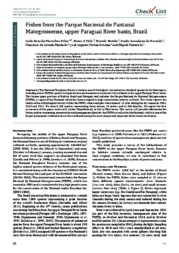Fishes from the Parque Nacional do Pantanal Matogrossense, upper Paraguai River basin, Brazil.
Fishes from the Parque Nacional do Pantanal Matogrossense, upper Paraguai River basin, Brazil.
Autoria: POLAZ, C. N. M.; MELO, B. F.; BRITZKE, R.; RESENDE, E. K. de; MACHADO, F. de A.; LIMA, J. A. F. de; PETRERE JUNIOR, M.
Resumo: The Pantanal Biosphere Reserve contains one of the highest concentration of animal species in the Neotropics, including about 300 fish species living in diverse environments associated with wetlands in the upper Paraguai River basin. This biome spans portions of Bolivia, Brazil and Paraguay and includes the Parque Nacional do Pantanal Matogrossense (PNPM), a region of the Pantanal which has been assigned as high conservation priority in Brazil. This study reports the results of an ichthyological survey within the PNPM, where samples were taken at 12 sites during the dry season in 2001, 2010 and 2011. We record 182 species representing three classes, 10 orders and 41 fish families. We report the first occurrence of the genus Anchoviella (order Clupeiformes), in the La Plata basin. This survey will provide information for future studies concerning conservation and management plans for the PNPM as well as for the Pantanal, which is one of the largest permanent wetland areas in the world and among the most unique and important South American biomes.
Ano de publicação: 2014
Tipo de publicação: Artigo de periódico
Unidade: Embrapa Pantanal
Palavras-chave: Biome, Paraguai River, Species, fish
Observações
1 - Por padrão são exibidas publicações dos últimos 20 anos. Para encontrar publicações mais antigas, configure o filtro ano de publicação, colocando o ano a partir do qual você deseja encontrar publicações. O filtro está na coluna da esquerda na busca acima.
2 - Para ler algumas publicações da Embrapa (apenas as que estão em formato ePub), é necessário ter, no celular ou computador, um desses softwares gratuitos. Sistemas Android: Google Play Livros; IOS: iBooks; Windows e Linux: software Calibre.
Acesse outras publicações
Acesse a Base de Dados da Pesquisa Agropecuária (BDPA) para consultar o acervo completo das bibliotecas da Embrapa.

